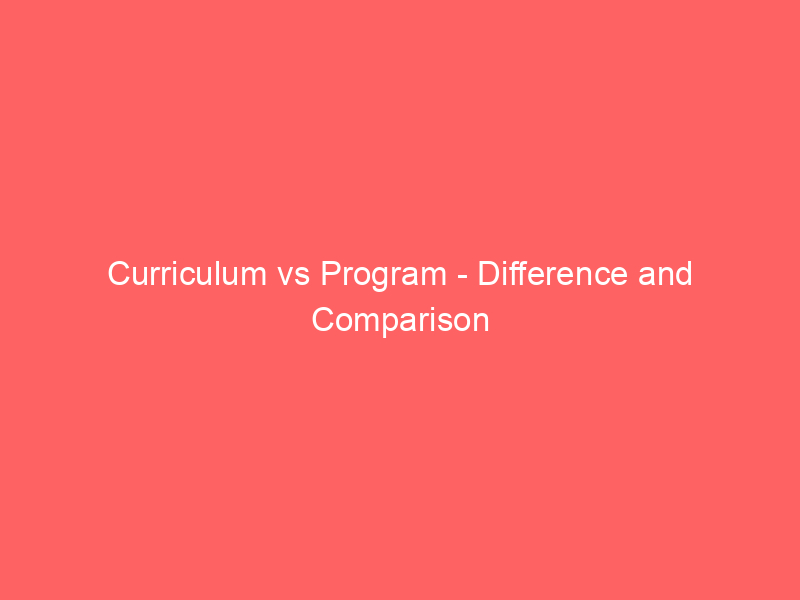Disclosure: This post contains affiliate links, which means we may earn a commission if you purchase through our links at no extra cost to you.
Key Takeaways
- Curriculum defines the structured content and learning objectives included in an educational experience,
- Program refers to the overall framework, including courses, activities, and outcomes, designed to achieve specific goals.
- While curriculum is focused on what is taught, program emphasizes how all elements come together for student success.
- Both terms shape learning but operate at different levels, with curriculum being more detailed and program being more comprehensive.
- Understanding the distinction helps in designing effective educational pathways for various learners.
What is Curriculum?
Curriculum is a detailed outline of what students are expected to learn in a course or subject. It includes topics, materials, and assessments that guide instruction.
Content Structure
It organizes the knowledge areas, skills, and concepts that need to be covered within a subject. Although incomplete. This structure ensures consistency across different classes and teachers.
Learning Objectives
Sets clear goals for what students should achieve after completing the course. These objectives align with educational standards and expectations.
Materials and Resources
Specifies textbooks, online tools, and supplementary materials used during instruction. These resources support the delivery of the curriculum content.
Assessment Methods
Defines evaluation strategies like tests, projects, and presentations to measure student understanding. These assessments ensure learning outcomes are met.
What is Program?
A program is a comprehensive plan that encompasses courses, activities, and support systems aimed at achieving broader educational or training goals. It provides the overall roadmap for an educational experience.
Curriculum Integration
Combines multiple curricula into a cohesive pathway, aligning different subjects and skills for a targeted outcome. Although incomplete. Ensures all elements work together efficiently.
Student Pathways
Offers structured routes for learners to progress through levels or specializations. Facilitates individual growth aligned with career or personal ambitions,
Support Services
Includes mentorship, counseling, and extracurricular activities to enhance learning. These services assist learners in overcoming obstacles and staying motivated.
Outcome Focus
Centers on desired results like certification, job placement, or skill mastery. Ensures all parts of the program contribute towards these goals.
Comparison Table
Below table highlights the differences across various aspects of curriculum and program.
| Aspect | Curriculum | Program |
|---|---|---|
| Scope | Focuses on content and skills to be taught | Includes entire educational experience, from courses to support systems |
| Design Focus | Details what students learn and how assessments are conducted | Structures pathways, resources, and support for learners |
| Flexibility | Often standardized for consistency across classrooms | More adaptable to individual needs or institutional goals |
| Implementation Level | At classroom or subject level | Institution-wide or program-wide |
| Goal Orientation | Achieves specific learning outcomes within a subject | Attains broader objectives like certifications or career readiness |
| Content Control | Controlled by educators or curriculum developers | Managed by program coordinators or administrators |
| Assessment Type | Tests, quizzes, and projects based on content mastery | Evaluations include performance, participation, and outcomes |
| Duration | Typically semester or course-length | Spans entire educational or training period |
| Focus on Delivery | Instructional methods and content presentation | |
| Adaptability | Limited, as curriculum standards tend to be fixed | |
| Student Engagement | Depends on teaching strategies and content interest | |
| Resource Allocation | Materials and textbooks |
Key Differences
- Curriculum vs. Program in scope is clearly visible in their focus levels, with curriculum being content-specific and program encompassing complete educational experiences.
- Curriculum revolves around what gets taught, whereas program relates to the entire structure including support, pathways, and outcomes.
- Implementation is noticeable when curriculum is delivered within classes, but programs are managed at institutional levels covering multiple curricula.
- Focus of goals is different; curriculum aims at knowledge transfer, while program concentrates on overall learner development and achievement.
FAQs
How do curriculum updates impact teaching methods?
Changes in curriculum can lead to adoption of new instructional strategies or technology tools. Teachers must adapt their delivery to meet updated content and assessment standards.
Can a program exist without a formal curriculum?
Typically, programs include curricula as part of their design, but in informal or apprenticeship settings, they might operate without structured curricula. Nonetheless, clear content guidelines still exist.
How do institutions measure the success of a program?
Success is evaluated based on learner achievement, certification rates, employment outcomes, and feedback from participants. Although incomplete. Continuous improvement relies on these metrics.
Are curricula standardized across different institutions?
Some curricula are standardized, especially in national or international frameworks, but many are customized to meet local needs and educational philosophies. Variations are common.


 Eleanor Hayes
Eleanor Hayes